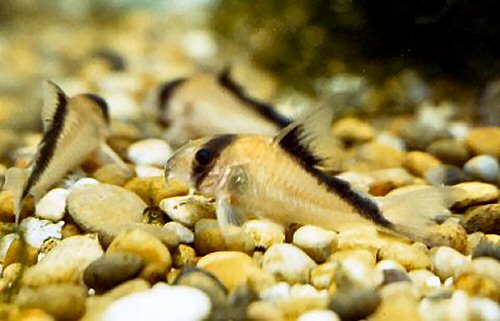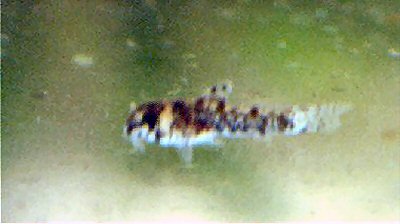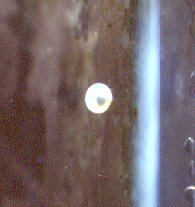SCOTCAT.COM
your internet guide to all things catfish
| Breeding Corydoras davidsandsi, Black 1987 |
by Allan James |
Hoplisoma
davidsandsi The picture above shows the black stripe running along the ridge of the back. I purchased two pairs from different outlets and placed them in a 18" x 12" x 12" tank with aged water, pea gravel, Java moss, Java fern and a sponge filter, but little did 1 know the problems I would have trying to spawn them even though one of the females was quite heavy. I fed them my usual, being flake food, tablets, white worm, daphnia and bloodworm (live and frozen) also undertaking 50% cool water changes twice a week but 1 just could not get them to start. My usual visitors to my fish house would come in and the first thing they would say would be, "have you not got them spawned yet?". This went on for three months until I decided to give them one more try. I placed a powerhead in the tank for extra aeration and then carried out a 75% water change with part rainwater and flooded the tank with white worm, I then locked the fish house and hoped for the best. Yes you know what I'm going to say, the next morning 1 found a total of 14 eggs laid on the Java moss and Java fern. 1 then removed the eggs and put them into a small tank with water from the breeding tank . I used light aeration, but three days later only four hatched as eight had fungused and two where not fertilized. I had to go away for two days and I lost the fry due to not being able to change the water. I needn't have worried though for a week later they spawned for me again, they laid only five eggs this time which I put into my small tank again, but with no aeration this time. 1 also added meth. blue to the water.
Hoplisoma davidsandsi - 11 days old
Hoplisoma davidsandsi - egg
They hatched in three days, and after two days I started feeding microworm as first food along with egglayer fry food. I am doing 50% water changes every day. The next spawning was a week later, this time thirty eggs were laid. I watched the spawning sequence this time which occurred at 9am. in the morning. One male chased the larger female as they took up the customary 'T" position, with the male grabbing the females barbels with his pectoral fins and pushing her very hard, she then broke away from him after about eight seconds, then she sat on her side for a further few seconds, then expelled one egg into her ventral fins. She would travel about the tank with the male chasing her for what seemed ages, before she would lay the egg usually in the Java moss but sometimes on the glass. I noticed that the other male was trying to get into the act but the dominant male was chasing him away so he would go and try to spawn with the other female, but she was never interested. I keep the fry in the small tank for two weeks, then I move them to a seven gallon growing on tank with a corner filter, doing water changes every other day. This is when I start feeding brine shrimp as well as microworm and crushed flake. This (out of focus!) picture above is of an 11 day old fry. They spawned quite regularly for me after that, with six to ten days between broods. The other female is also producing now, so 1 am getting spawns from anything between twenty and fifty eggs from the two pair. For the record the pH was 6.8 with the temp. being 80F during the day and dropping to 76F during the night in my fish house. The water is very soft in this part of Scotland at G.H.l. A lesson I have always learned from breeding Corydoras/Hoplisoma is to have patience and plenty of it. Lineage: Placed in Lineage 9, the "short-snouted" species with the designated type species: C. punctatus. A revision in the future would constitute the resurrection of the genus name Hoplisoma (Agassiz, 1846). As of the latest revision (Dias et al 2024) Corydoras davidsandsi has now been placed in Lineage 9 and has the new genus name of Hoplisoma.
Photo Credits:
Allan James @
|
If you would like to contribute an article, please e-mail me. You will of course be credited for your work.
If you would like to donate any denomination of money to the site just click the above link button. All proceeds will go to running the site and hopefully to keep it going for a few years yet.
Print or e-mail this factsheet below




